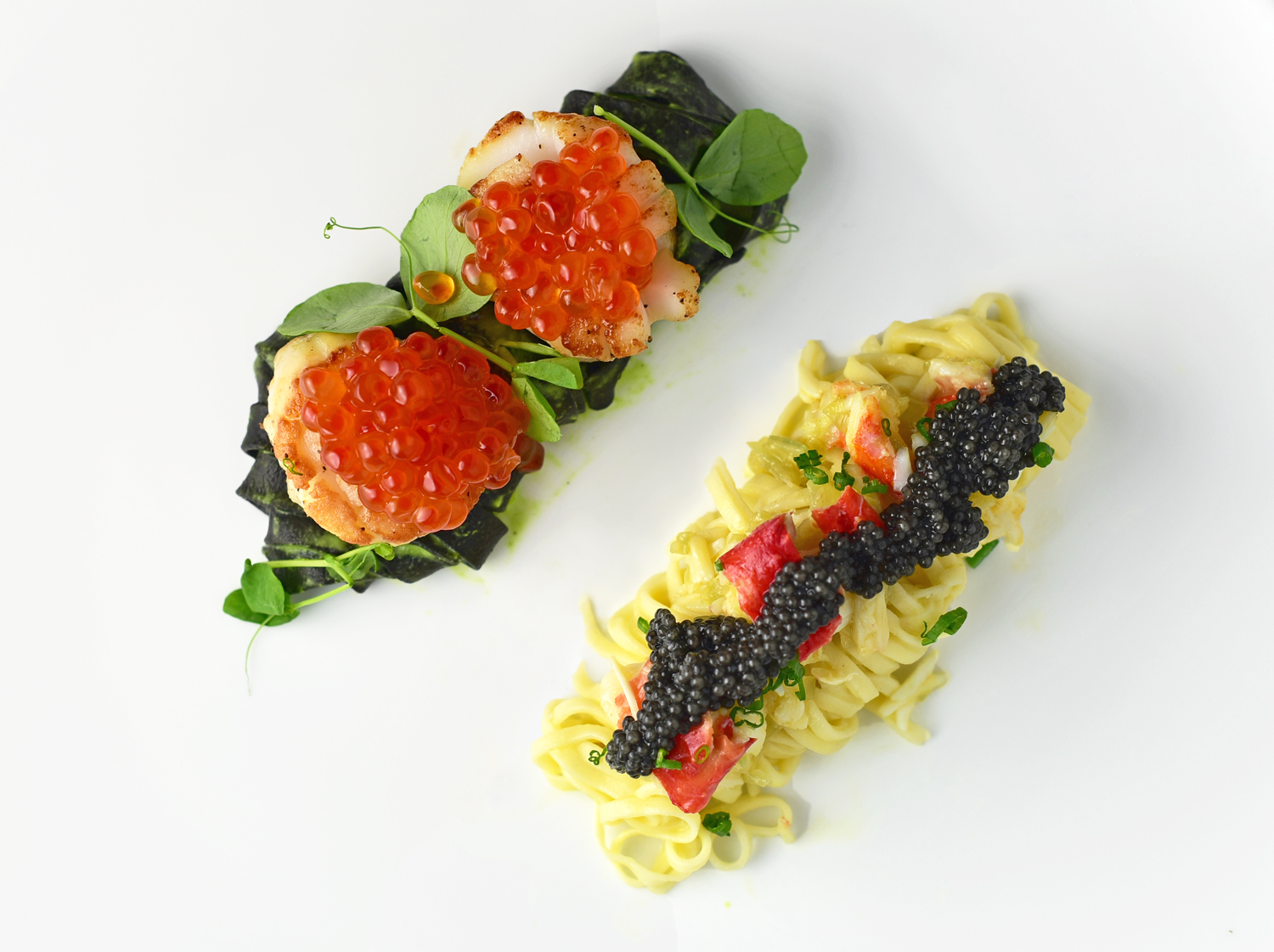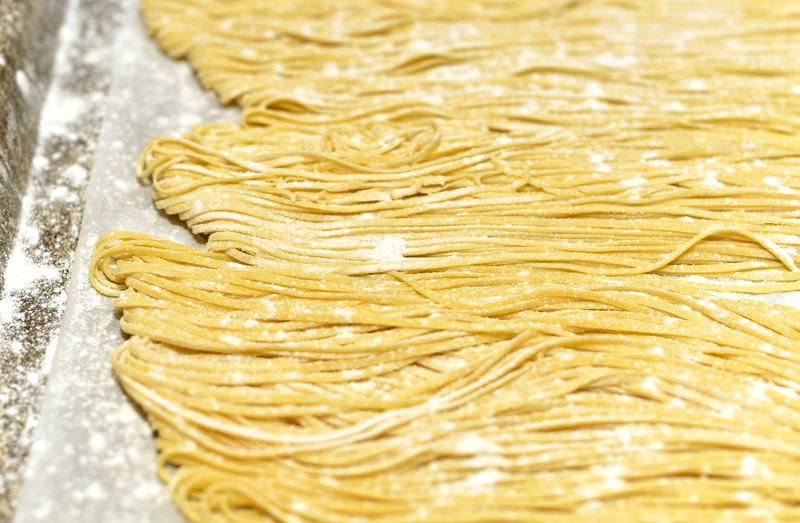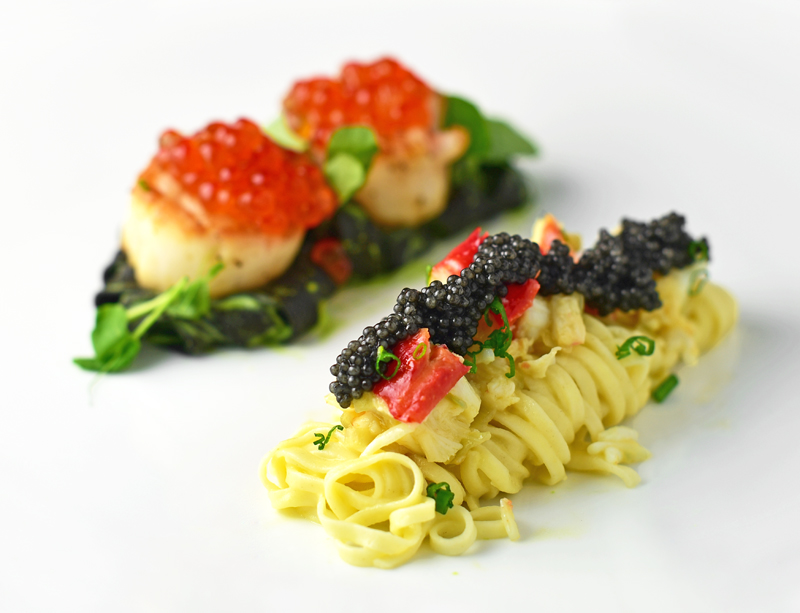It all begins about 20 years ago in Moscow. There aren’t that many noteworthy restaurants in the Russian capital yet. I don’t know if Pizzeria San Marco, on the Arbat, really counts as noteworthy (it just serves pizza and pasta), but hey, it’s near the small apartment where I’m staying, and in the middle of the economic turmoil that sees the ruble plunging endlessly and most Russian food products completely disappearing from store shelves, it serves spaghetti with king crab and caviar, at a very reasonable price for a tourist. Heresy? If it was prepared in a tomato sauce, then yes, definitely, but instead it comes with a simple cream sauce. And in terms of ingredients, pasta isn’t all that different from bread or blini: essentially flour, salt, and eggs. Considered from that angle, it’s only a slight variation on the traditional caviar serving, and the dish works actually quite well.
Fast forward 10 years. I’m finishing the Culinary Arts program at the Institute of Culinary Education in New York, and our graduation project consists in part of creating a complete restaurant menu. I come up with an Eastern European theme, surprising no one, and one of my dishes is inspired by San Marco’s New-Russia-meets-Italy spaghetti. I also decide to create a second fish roe/pasta combination, to be served at the same time, with colors echoing the palette of the original: squid ink linguine for the black caviar, salmon roe for the red Kamchatka crab, and bay scallops for the the plain pasta. Concision be damned, I call it Duo of Seafood and Caviar Linguine – Egg Linguine with Kamchatka Crab, Artichokes and Caviar – Squid Ink Linguine with Bay Scallops, Salmon Roe and Corn Cream.
Fast forward another 10 years. I realize that since starting this blog, I’ve posted very few of the recipes I created during and shortly after my culinary school days. I have plenty of notes, though; everything is stored more or less neatly in a wiki. My partner is pushing me to redo one of those recipes for her birthday, and her preference goes to the caviar linguine. I look into my archives. The picture looks embarrassing but the recipe’s still interesting. With the intervening years of cooking experience under my belt, I make some tweaks, though not too many: the artichokes are replaced with green peas, and I rethink the way that all the elements are assembled. Thankfully, my plating and photographic skills have improved considerably (I’ll spare you the eyesore of the original photo). All in all, it makes a tasty and beautiful meal for a special occasion.
Some might complain that this drifts too far away from their idea of the Russian cuisine canon. “Wherever did that Food Perestroika guy find scallops in Russia?!” But if you think for a moment upon the origins of the ingredients in San Marco’s dish, you’ll discern a strange amalgam from the start: the caviar used to come from the Caspian Sea and the king crab from Kamchatka — places almost 10,000 km apart. All that these seafoods have in common is that they’re luxury ingredients hailing from the Russian Empire, and were probably first enjoyed together at the tables of various nobility. Unbeknownst to many, scallops in Russia, both wild and farmed, also hail from Russia’s far east, even if production, though growing, is still vastly inferior to that of crab, and nothing comparable to what goes on in Asia or America. Salmon roe comes from the far east too, which actually makes the scallop-salmon roe pairing much more geographically plausible than caviar-king crab.
While this isn’t a cheap dish, you don’t need to take out a second mortgage either. The servings are relatively small. Instead of sturgeon caviar, paddlefish roe works very well, if not better. But I must warn you, plating both pasta preparations on one plate at the same time is hard. This will typically require 2 pots of water, 3 saucepans and 1 frying pan, almost all of them used simultaneously, so it helps to be well organized. And you’d better memorize what goes on top of what ahead of time! Or you can serve the fettuccine and linguine as two different courses — each one of them is a delicious dish in its own right.
Plain linguine
Yields over 8 servings
75 g eggs
10 g olive oil
1 g salt
160 g AP flour, plus some for dusting
- Place the eggs, olive oil, and salt in the bowl of an electric mixer fit with the paddle attachment. Beat on medium speed, and mix in the flour in two additions, until homogeneous, scraping down the sides with a spatula.
- Transfer to a floured surface, and knead with your hands for about 3 minutes. If necessary, add a little bit more flour until the dough doesn’t stick. Wrap in plastic and let rest for 30 minutes.
- Using a pasta machine, roll the dough to the thinnest setting, keeping the pasta sheets on a floured tray. Cut the pasta into linguine (using the proper attachment on your pasta machine). Return to the tray, dust with some more flour, and reserve.
Squid ink fettuccine
Yields over 8 servings
75 g eggs
10 g olive oil
15 g cuttlefish ink
0.5 g salt
160 g AP flour, plus some for dusting
- Place the eggs, olive oil, cuttlefish ink, and salt in the bowl of an electric mixer fit with the paddle attachment. Beat on medium speed, and mix in the flour in two additions, until homogeneous, scraping down the sides with a spatula.
- Transfer to a floured surface, and knead with your hands for about 3 minutes. If necessary, add a little bit more flour until the dough doesn’t stick. Wrap in plastic and let rest for 30 minutes.
- Using a pasta machine, roll the dough to the thinnest setting, keeping the pasta sheets on a floured tray. Cut the pasta into fettuccine (using the proper attachment on your pasta machine). Return to the tray, dust with some more flour, and reserve.
Corn purée
Yields 4 servings
180 g corn kernels
120 g chicken stock
30 g heavy cream
salt
- Place the corn kernels, chicken stock, and heavy cream into a small saucepan. Bring to a boil, and simmer for 30 seconds.
- Transfer to a blender, season with salt, and process until smooth.
- Pass the corn purée through a chinois, and reserve. The purée will thicken when you reheat it, so don’t be alarmed if it looks thin.
Kamchatka crab meat
Yields 4 servings
about 250 g cooked king crab legs
30 g peeled shallots, small dice
30 g butter
- Remove the shells and cartilage from the crab legs. Coarsely chop the crab meat from the legs, crumble the meat from the shoulders, then mix together and reserve. You should have about 120 g meat.
- In a small saucepan over medium heat, sauté the shallots in the butter until translucent. Remove from the heat, mix in the crab meat, and reserve.
Crab and caviar linguine
Yields 4 servings
1/2 of plain linguine
salt
10 g butter
corn purée
Kamchatka crab meat
about 40 g sturgeon caviar (or paddlefish roe)
about 2 g chives, thinly sliced
- Cook the pasta in salted boiling water.
- Drain the pasta, then transfer to a bowl and toss with the butter. (This is a good place to pause if you plan to serve both the crab-caviar linguine and the scallop-salmon roe fettuccine together.)
- Add the pasta to a saucepan with the corn purée. Cook over low heat for about a minute, stirring constantly.
- Gently reheat the crab meat in a saucepan if necessary. You don’t want the crab (or pasta) to be too hot, as you need to avoid cooking the caviar.
- Roll some linguine over a carving fork, transfer to a plate, and top with some crab meat. Repeat with the other plates, then top with some caviar, sprinkle with chives, and serve immediately.
Green pea purée
Yields 4 servings
180 g frozen green peas
80 g chicken stock
25 g heavy cream
salt
- Place the green peas, chicken stock, and heavy cream into a small saucepan. Bring to a boil, and simmer for a minute.
- Transfer to a blender, season with salt, and process until smooth.
- Pass the pea purée through a chinois, and reserve.
Sautéed scallops
Yields 4 servings
8 sea scallops (about 200 g)
salt
black pepper, ground
Wondra flour
canola oil
10 g Cognac
- Score the tops of the scallops with a knife, making a cross-hatch pattern about 1 cm deep. Season both sides with salt and pepper, and dust with Wondra flour.
- In a pan over high heat, sauté the scallops in the canola oil, cross-hatch side down, until brown. Flip, add the Cognac, and remove from the heat after a few seconds, so that the scallops are still slightly undercooked. Reserve in a warm place, and proceed with the next steps.
Scallop and salmon roe fettuccine
Yields 4 servings
1/2 of squid ink fettuccine
salt
10 g butter
green pea purée
1 pinch lemon zest, cut into a fine brunoise
sautéed scallops, still warm
about 60 g salmon roe
about 2 g pea shoots
- Cook the pasta in salted boiling water.
- Drain the pasta, then transfer to a bowl and toss with the butter. (This is a good place to pause if you want to serve both the crab-caviar linguine and the scallop-salmon roe fettuccine together.)
- Add the pasta to a saucepan with the green pea purée and lemon zest. Cook over low heat for about a minute, stirring constantly. You don’t want the pasta (or scallops) to be too hot, as you need to avoid cooking the salmon roe.
- Roll some fettuccine over a carving fork, transfer to a plate, and top with a couple of scallops. Repeat with the other plates, then top with salmon roe, decorate with pea shoots, and serve immediately.







1 comment
A nice story! Spasibo !